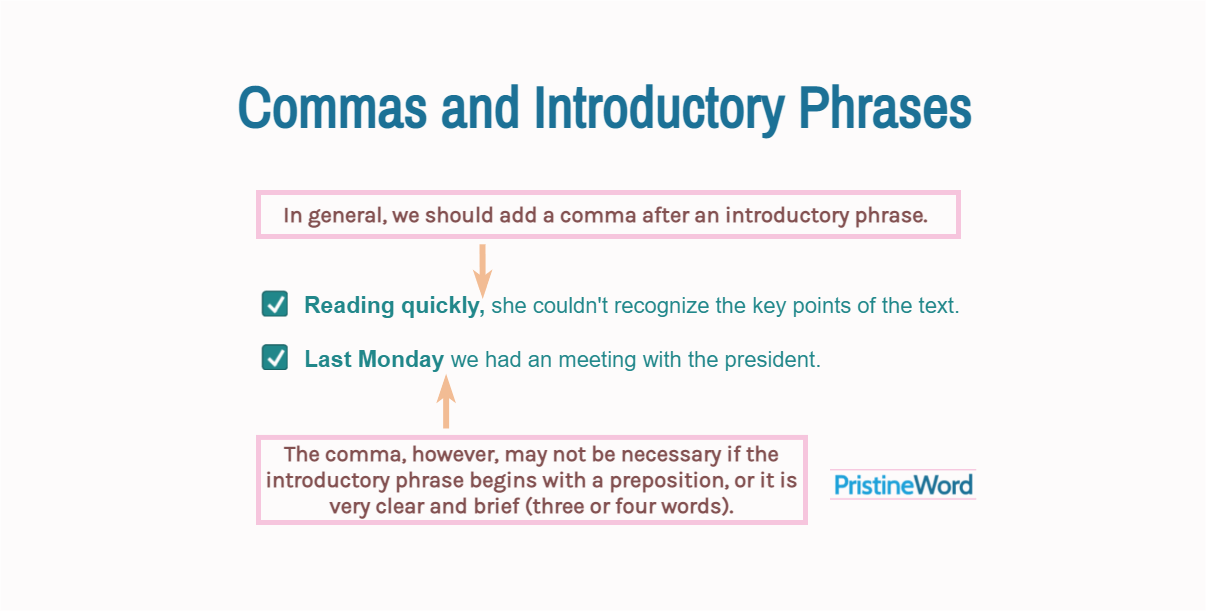Generally, we should add a comma after an introductory phrase. The comma, however, may not be necessary if the introductory phrase begins with a preposition, or it is very clear and brief (no more than three or four words).
Generally, we should add a comma after an introductory phrase.
Reading quickly, she couldn't recognize the key points of the text.
The comma, however, may not be necessary if the introductory phrase begins with a preposition, or it is clear and brief (no more than three or four words).
On average 5 percent of Americans experienced high-stress levels in 2020.
Last Monday we had a meeting with the president.
Contents
1. What Is an Introductory Phrase
An introductory phrase is a group of connected words that:
- comes before the main clause in a sentence
- does not have a subject and a verb (it can have a subject or a verb, but not both)
- adds information to the main clause (for example, about timing or location)
Examples of introductory phrases
- After finishing his work, Monica went to bed.
- Completely oblivious to my presence, she kept talking about me.
- To be a good doctor, you need to improve your communication skills.
2. When to Use a Comma After an Introductory Phrase
As a general rule, we should use a comma to separate an introductory phrase from the rest of the sentence.
Having finished her law studies in Chicago, Jennifer moved to San Francisco.
Having finished her law studies in Chicago Jennifer moved to San Francisco.
If the introductory phrase is clear and short (no more than three or four words), the comma is optional.
When in town we go to the movies.
When the introductory phrase starts with a preposition, a comma may not be necessary even if the phrase contains more than four words.(1)
Before starting the important meeting the president said a few words.
In the very beginning of the movie the good guy was shot.
But use a comma to clarify or avoid misreading.
Last Tuesday, morning classes were cancelled.
Add also a comma when preceding a subordinate clause, signaling a pause, or setting off parenthetic expressions, even if the introductory phrase is very short.
In winter, when the freezing temperatures chill, I enjoy reading romance novels before going to bed.
When in doubt, use a comma after the introductory phrase—unless it defines or limits.
To be a good employee, use your best effort and focus on solutions.
Recommended: Comma after 'well', 'why', 'hello', 'hey', and other introductory words
More examples
- In Summer, we plan creative picnics.
- As for inflation pressures, commodity prices keep rising across the board.
- After having considered the evidence carefully, we find you guilty of murder.
- During the day I eat too much.
- When in Thailand, I enjoy eating street food and spicy soups.
- Before the heavy rain some storm clouds gathered.
- Opening the door, I discovered that my wife was with her ex-husband.
Recommended: Commas and time adverbs
3. When Not to Use a Comma
Do not use a comma if the introductory phrase is essential to the meaning of the sentence or helps identify the subject.
The award-winning actress Linda Wilson announced that she was pregnant.
The award-winning actress, Linda Wilson announced that she was pregnant.
Use a comma, however, if the introductory phrase simply provides an alternative description, which can be easily separated or treated separately.
A great and renowned scientist, Susan Lopez, led the research and innovation project.
Recommended: Comma after "yes" and "no"
More examples (no comma)
- The renowned director Alfred Hitchcock died in 1980.
- The chief executive officer Nancy Davis is highly regarded in the US.
- The history teacher Margaret Taylor contends that the French Revolution was caused by a financial crisis.
- The engineer Elizabeth Williams was found dead last night.
4. Commas and Different Types of Introductory Phrases
The main types of introductory phrases are:
- prepositional
- infinitive
- participial
- absolute
- appositive
Prepositional phrases are introduced by a preposition (at, in, after, by, for, with, etc.). As mentioned before, a comma after an introductory prepositional phrase is not always necessary.
After World War II the European economy had collapsed.
Infinitive phrases are introduced by the word "to" and followed by a verb. We use a comma after an introductory infinitive phrase to set it apart from the rest of the sentence.
To run the program, double-click the executable file.
Participial phrases are introduced by a participle, that is, a word formed from a verb (e.g., "having", "running", or "gone"). Add a comma after a participial phrase to introduce a sentence.
Opening his eyes, he discovered a black bear near the house.
Absolute phrases modify the main clause and can be removed without affecting the meaning of the sentence. Introductory absolute phrases should be followed by a comma.
Completely unaware of the storm around the corner, Amanda decided to go ahead.
Appositive phrases provide an alternative description of a noun in a sentence. We should add a comma after an introductory appositive phrase unless the appositive phrase defines or limits.
A great investor and American businessman, David Anderson is widely considered to be the most successful entrepreneur last year.
5. References
(1) Kaufman, Lester; Straus, Jane. The Blue Book of Grammar and Punctuation. Chapter 2 (punctuation).

